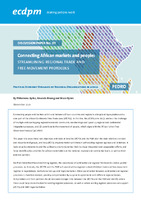| dc.description.abstract | Connecting people and markets within and between African countries and regions is a longstanding aspiration of its
leaders. The objective goes back to the pre-independence pan-Africanist movement, before re-emerging in the
1970s with the moves towards creating an African Economic Community.1 This aspiration is implicitly also included
in the ‘Agenda 2063: The Africa we want’ which cites the desire of African Union (AU) member states to move
towards ‘shared prosperity and wellbeing...’, to achieve ‘a prosperous Africa based on inclusive growth and
sustainable development’ and ‘an integrated continent, politically united and based on the ideals of Pan-Africanism
and the vision of Africa’s Renaissance’.
Those ambitions remain a core part of the African Continental Free Trade Area (AfCFTA), the current, major African
initiative to promote socio economic development across the continent. The first stated objective of the AfCFTA is
to “create a single market for goods, services, facilitated by movement of persons in order to deepen the economic
integration of the African continent and in accordance with the Pan African Vision of ‘An integrated, prosperous and
peaceful Africa’ enshrined in Agenda 2063”.2 This would mean connecting 1.3 billion people across 55 countries with
a combined GDP valued at $3.4 trillion, with an estimated impact of lifting 30 million people out of extreme poverty
by 2035 (World Bank 2020). However, though the African Union Free Movement of Persons Protocol (AU-FMP) was
opened for signature the same day as the AfCFTA Agreement, only four countries have yet ratified the AU-FMP,
compared to 38 countries for the AfCFTA.3 That contrast in political traction underlines the challenge of connecting
markets and people in practice.
This paper therefore discusses two specific objectives of the AfCFTA: the first is to “resolve the challenges of multiple
and overlapping memberships and expedite the regional and continental integration processes”, an objective that
speaks to the fact that almost all AU member states are party to more than one regional economic community (REC),
not to mention the set of additional sub regional groupings; the second is to “contribute to the movement of...
natural persons... building on the initiatives and developments in the State Parties and RECs” (AU 2018a), where this
aligns with the AU-FMP objectives. These also emerged as key areas of interest for policymakers in Africa and in
Europe through a series of interviews, webinars and desk work undertaken for this paper. The focus here is therefore
on the practicalities of promoting free trade and movement of people while simplifying regional overlaps. |

